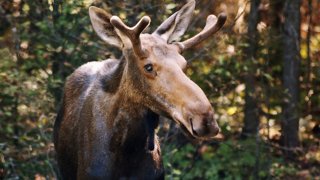
Connecticut’s Department of Energy and Environmental Protection Wildlife Division reminds motorists to be watchful of increased deer and moose activity along roadways, especially during early morning and evening hours.
Connecticut drivers are being urged to watch out for deer and moose, especially during early morning and evening hours.
The state Department of Energy and Environmental Protection issued a warning on Tuesday, saying May and June are the birthing period for deer and moose.
While Connecticut's moose population is mainly in the northwestern part of the state, they can be seen in eastern Connecticut as well.
Get Connecticut local news, weather forecasts and entertainment stories to your inbox. Sign up for NBC Connecticut newsletters.
Moose become highly active in the spring when last year’s offspring leave the mother and during the breeding season, from mid-October for moose through mid-December for deer, according to DEEP.
DEEP’s Wildlife Division urges drivers to slow down and drive defensively if they see a large animal, such as a deer, moose, or even a black bear, on or by the road.
They warn that it is less likely to see the eyes of a moose in the headlights and, when struck, often hit the windshield of a vehicle.
At night, look higher than you normally would for deer and reduce the speed of your vehicle.
If you are involved in a collision with wildlife, report it to local, state, or DEEP Environmental Conservation Police Officers. DEEP’s 24-hour Dispatch Center can be reached at 860-424-3333.
Stories from LX News
LX, or Local X stands, for the exponential possibilities of storytelling in our communities.
In addition to the crash in Goshen, Andrew LaBonte, Deer and Moose biologist for the DEEP Wildlife Division, said there have been moose sightings in the Storrs/Mansfield area, as well as in Ashford.
“(M)otorists are advised to drive with caution along Routes 32 and 44 and near Mirror Lake on Route 195,” LaBonte said in a statement.
He said more than 40 accidents involving moose and vehicles accidents have been reported in Connecticut between 1995 and 2021 and there have been an average of two per year since 2002.
DEEP said moose venturing into southern Connecticut, with the high population density, road networks and traffic volumes, pose an increased potential for human deaths from accidents as compared to crashes involving deer and vehicles.
You can report moose sightings on the DEEP website online here.